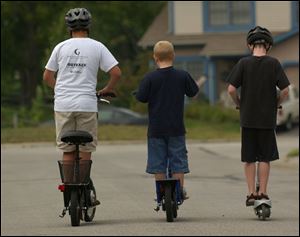
Danger is a scooter rider's companion
8/22/2004
The increased use of motorized scooters by young riders has authorities concerned about regulations controlling their use, rider safety, and the enforcement of traffic laws.
Sandra Wingate had experience riding an electric scooter when she hopped on one of the popular little vehicles and went for a ride with her cousin.
The smiling 9-year-old had always been safe, Michelle Wingate, said of her youngest daughter. But something unexpected happened this time as she rode one of the zippy scooters.
Sandra was going west Aug. 10 in the eastbound lane of Arzella Drive in the Lambertville area when she did not stop for a stop sign. She turned into the northbound lane of Maplewood Avenue, where a northbound pickup struck her, causing fatal injuries.
Sandra was not wearing safety gear, Mrs. Wingate said.
"Just make sure your kids have every little safety thing they can have," the grieving mother advised parents as she choked back tears.
Law-enforcement officials throughout the region are concerned about these types of vehicles and others - such as minimotorcycles or "pocket bikes" - that are prohibited from streets and sidewalks unless they are titled, registered, covered by insurance, and have the correct equipment, such as turn signals and mirrors. Riders also must have a license.
Motorized scooters that do not have a seat are not legal on streets or sidewalks and cannot be titled. They and the other unlicensed vehicles can only be ridden on private property.
Although enforcement is not uniform, area agencies are increasing efforts to control the growing number of small, motorized scooters that zip up and down roads.
Last year, 8,000 injuries occurred nationally on motorized scooters, a number that pales to 52,200 sustained on the foot-powered models. But injuries on motorized scooters increased over the prior two years while those sustained on foot-powered scooters were cut almost in half, said Scott Wolfson, U.S. Consumer Product Safety Commission spokesman.
Each year, head wounds lead the list of injuries on foot-powered scooters.
"It's still important to keep in perspective that motorized and foot-powered [scooters] both present hazards to children. In both situations, the kids should be wearing helmets," Mr. Wolfson said.
Riders also should strap on elbow and knee pads.
Monroe County Sheriff Tillman Crutchfield said his office, like other agencies, has fielded an increasing number of complaints about the sometimes difficult-to-see scooters.
He told his deputies to begin tougher enforcement of Michigan laws that restrict the
operation of such vehicles, which are nicknamed "gopeds" and fall under the moped law. Enforcement could range from a friendly warning, taking the young rider home, confiscating the scooter, and issuing a citation.
Sylvania Police Chief Gerald Sobb ordered his officers to begin issuing written warnings to those operating the vehicles on city streets or sidewalks. One of the factors that led him to enforce existing laws is that the vehicles are difficult for motorists to see and some of them can go as fast as the speed limit.
Rather than ask city council for an ordinance prohibiting the vehicles, he uses existing laws that ban motor vehicles that are unlicensed. Other agencies, such as the Toledo Police Department, are doing the same.
Sylvania councilman Keith Haddad strongly supports restrictions on small scooters and cycles. Recently, he was about to make a left turn when one passed him on the left.
"If I hadn't seen him earlier in my rear view mirror, I'd have turned right into him. It's just lucky I already had a sense that he was there," he said.
Last year, Rossford city council passed what is known as the "toy vehicle" ordinance meant to control the use of motorized scooters.
Glenn Goss, community services officer with Rossford police, said the city law bans the vehicles from streets, but allows them under certain circumstances on sidewalks. He said officers are to use common sense in dealing with the situation involving these vehicles.
"It's a lot like street football. If the kids are at a dead-end street and they break up and get out of the way when a neighbor comes home there probably won't be any complaints. But if they're trying to play football on Dixie Highway, then we have a very different situation," Officer Goss said.
The problem of safety with the little vehicles is not limited to northwest Ohio and southeast Michigan. During the last few years, other cities and states have enacted ordinances or laws to deal with the vehicles.
Fred Stratmann, spokesman for the Ohio Bureau of Motor Vehicles, said the agency has received numerous calls from people who want to know if the vehicles are street legal and how they can make them legal.
"It's important for people to realize there are very specific requirements. It's a safety issue," he said.
Toledo police Sgt. Al Papenfus agreed.
"[These vehicles] are dangerous, inherently dangerous," he said.
Those caught zooming down the street or sidewalk on unlicensed vehicles can be cited for a number of offenses, including equipment violations. They can even be busted for drunken driving if they're intoxicated.
In Toledo, gas-powered scooters have to be towed, requiring tow and storage fees, Toledo Police Department Sgt. Paul Kerschbaum said. He and other authorities said adults who allow their children to ride these unlicensed vehicles on roadways or sidewalks also can be cited.
Contact Christina Hall at
chall@theblade.com
or 419-724-6007.